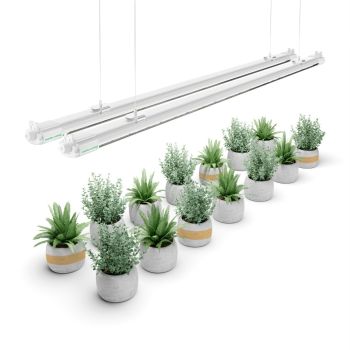
For robust ivy geranium growth and enviable blooms, understanding their care essentials is key. This guide dives into practical tips on sunlight, watering routines, and the best soil mixes. Uncover the steps to keep your ivy geraniums thriving year-round.
The Allure of Ivy Geraniums: An Overview
Ivy Geraniums, known scientifically as Pelargonium peltatum, are a breed apart. These aren’t your run-of-the-mill garden geraniums. Ivy Geraniums are cultivars and hybrids derived from a unique species, the same species that gave us the regal Martha Washington geraniums, also called regal geraniums, among others. What sets Ivy Geraniums apart is their most alluring feature - their cascading blooms. Imagine a hanging basket or window box overflowing with vibrant flowers in shades of red, pink, and violet, with delicate white accents. It’s a sight to behold, reminiscent of the stunning martha washington geranium.
However, their beauty isn’t just skin deep. Ivy Geraniums are also incredibly versatile. They can be grown in containers, baskets, or directly in the garden. And while their colorful blooms make them a favorite outdoor plant, geraniums grown in hanging baskets are particularly eye-catching. But there’s a catch. If you’re planning on growing Ivy Geraniums from seeds, you might not get exactly what you’re expecting. Often, these plants do not exhibit true characteristics when grown from seed.
Despite this, Ivy Geraniums, along with pansy geraniums and regal geraniums, are still a favorite among gardeners. Their vibrant colors, including the red geranium, versatility, and resilience make them a rewarding indoor plant to grow. Whether indoors or outdoors, in a hanging basket or a garden bed, Ivy Geraniums and heirloom geranium varieties bring a touch of timeless elegance to any space they occupy.
Optimal Lighting for Thriving Ivy Geraniums
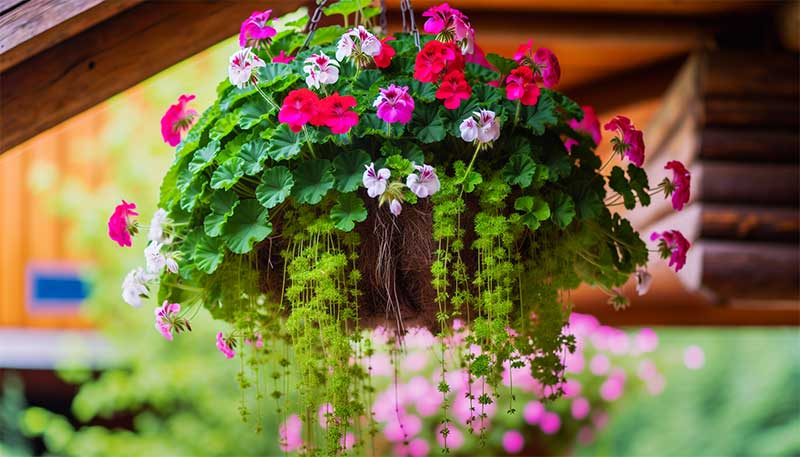
Ivy Geraniums need the correct amount of light to grow and bloom effectively, and their appearance may vary with a lighter or darker tone depending on the light conditions. These plants require full sun exposure and moderate summer temperatures to achieve optimal leaf color and flower production. Ideally, they should get four to six hours of direct sunlight each day to ensure ample blooming.
However, Ivy Geraniums, like most plants, can be sensitive to extreme heat. In fact, in the event of a heatwave, these plants may encounter a reduction or cessation in their flowering process. That’s why in regions with temperatures exceeding 85 degrees Fahrenheit, Ivy Geraniums may require partial shade to mitigate the adverse effects of heat on their growth. Their need for controlled light exposure renders them an apt choice for indoor cultivation.
Soil and Drainage Essentials
Ivy Geraniums are not particularly selective about their soil. They flourish optimally in well drained soil, such as a well-drained loam or sandy loam. You can improve soil health by incorporating organic matter. And if you’re growing them indoors, a sunny window is the best spot for them.
Despite their adaptability to various soil types, they cannot stand poor drainage. So, if you’re growing Ivy Geraniums in containers, ensure you opt for spacious ones. The potting mix should also facilitate adequate drainage, which you can achieve by incorporating sand or perlite. And remember to repot your potted ivy geraniums every couple of years as they tend to become root-bound.
Watering Wisdom for Ivy Geraniums
The watering of Ivy Geraniums requires a certain balancing act. On one hand, these plants need consistent watering for their health. On the other hand, they don’t like to be soaked. It’s important to let the soil surface dry out before each watering. And if you’re wondering when’s the best time to water them, I’d say in the morning. This prevents potential diseases as moisture remaining on the leaves overnight may lead to leaf discoloration.
On average, Ivy Geraniums require approximately one inch of water per week to thrive. But don’t just depend on a schedule. Always check the soil before watering. If the top inch or two of the soil has dried, that’s your cue. This approach aids in preventing overwatering and the development of soggy conditions, which can be harmful to the plants.
Fertilizing for Fabulous Blooms
Appropriate feeding is required for your Ivy Geraniums to bloom impressively. Some tips for feeding your Ivy Geraniums include:
-
Using slow-release fertilizers, such as Osmocote, which can elevate chlorophyll levels, stimulate flowering, and foster vegetative growth, all of which contribute to an increased bloom count.
-
Monitoring salts and pH levels to ensure optimal nutrient uptake.
-
Ensuring proper drainage to prevent waterlogged soil.
By following these tips, you can help your Ivy Geraniums thrive and produce beautiful blooms.
Providing continuous feeding with slow-release fertilizer or soluble plant food every two weeks is essential. This guarantees a steady supply of nutrients for your Ivy Geraniums, encouraging their vibrant and ongoing blooming cycle.
Pruning Practices for Dense and Decorative Growth
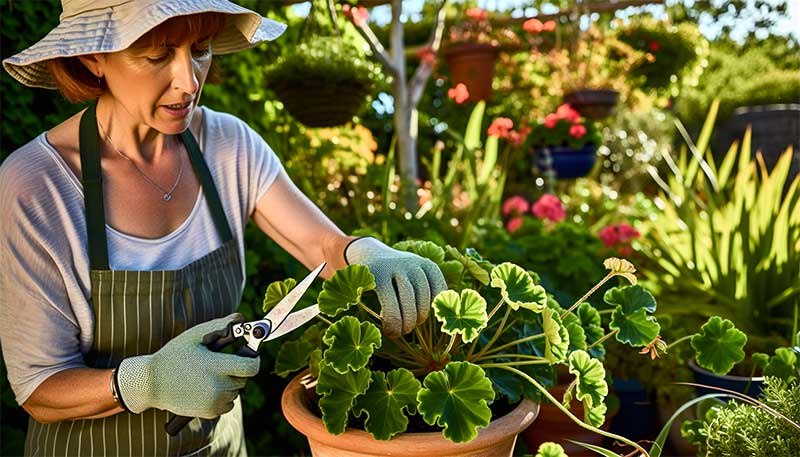
Pruning Ivy Geraniums serves not only to maintain their health but also to shape their growth. By pruning leggy Ivy Geraniums back by half, you can encourage dense, bushy growth and new blooms. This not only leads to healthier plants but also enhances their decorative value.
Deadheading or removing faded flower heads is another important part of pruning. This stimulates the growth of new blossoms, including ruffled flowers, resulting in prolonged flowering that extends well into the autumn season. Paying attention to the petal edges while deadheading ensures a clean cut. And when it comes to tools, a sharp, sterilized bypass pruner is your best bet for clean cuts that support the plant’s rapid recovery and regrowth.
Remember, the most suitable time for pruning Ivy Geraniums to achieve optimal growth is in the spring and fall.
Propagation Perfection: Stem Cuttings
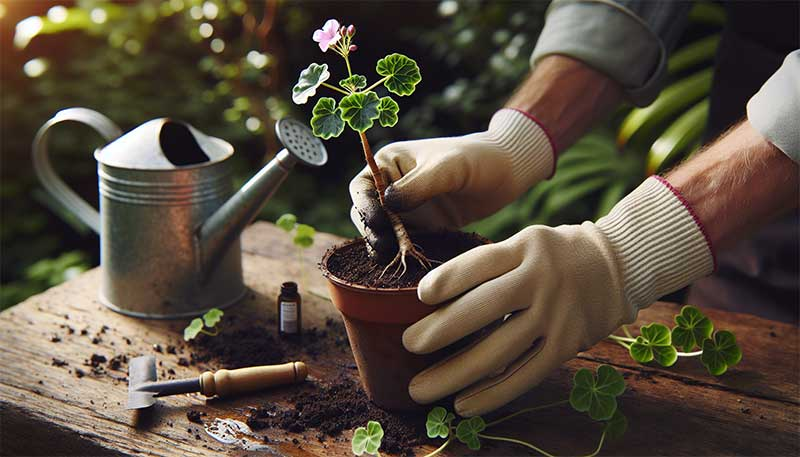
Propagation is one of gardening’s most rewarding aspects, and it is relatively straightforward with Ivy Geraniums. The optimal time for propagating these plants with stem cuttings is during the fall. This allows for the initiation of new plants indoors and their subsequent overwintering.
Here’s a simple step-by-step guide on how to do this:
-
Select healthy stems.
-
Trim off the lower foliage, leaving two or three leaves at the top.
-
Take a 3- to 4-inch-long section from the tip of the stem.
-
Immerse the cut end of the stem in fresh, warm water.
-
Plant it in well-draining potting mix.
-
Maintain soil moisture.
-
Position the cutting in a warm, bright location.
-
In about 6 to 8 weeks, you should see your cuttings successfully root.
Keep in mind, for this process, you’ll need the following items:
-
Clean shears or garden scissors
-
A sharp knife or small pruners
-
Small pots with drainage holes
-
Indoor potting soil
-
Coarse sand for drainage
-
A filled watering can
Combatting Common Pests and Diseases
Even with their versatility and resilience, Ivy Geraniums are not resistant to pests and diseases. Some of the more common issues include pests like mealybugs, spider mites, thrips, and fungus gnats, as well as leaf spot fungal disease.
Insecticidal soap is a great solution for addressing these pests, particularly soft-bodied insects like mealybugs, spider mites, and thrips. Also, refrain from overwatering, conduct frequent plant inspections, and use neem oil as a preemptive measure. However, be mindful of potential hazards associated with the application of neem oil, including toxicity to aquatic organisms and the possibility of foliage burn if applied incorrectly.
Winter Care for Indoor Ivy Geraniums
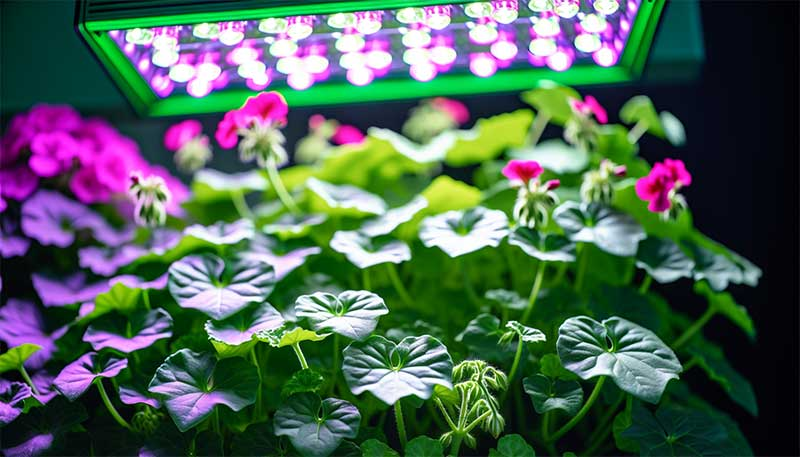
During winter, the reduced sunlight and cooler temperatures can pose a challenge for indoor Ivy Geraniums, potentially affecting their health and vibrancy. The Mars Hydro VG80 LED grow lights offer a practical solution to these seasonal challenges, ensuring the flourishing of these plants even in less favorable conditions.
Key Features of the Mars Hydro VG80 for Indoor Gardening:
1. Optimal Light Spectrum: The Mars Hydro VG80 is engineered to emit a full spectrum of light, encompassing both red and blue wavelengths. This comprehensive spectrum is particularly beneficial for Ivy Geraniums, as it supports both foliage growth and flowering. It effectively mimics the natural light conditions that these plants would receive outdoors.
2. Energy Efficiency: Given its energy-efficient design, the Mars Hydro VG80 is an economical choice for indoor gardeners. This efficiency is especially valuable during winter when the grow lights might need to be on for longer durations to compensate for the shorter daylight hours, ensuring that the plants receive sufficient light without significantly increasing energy costs.
3. Adjustable Light Intensity: The ability to adjust the light intensity of the Mars Hydro VG80 is a crucial feature for catering to the specific needs of Ivy Geraniums. Different stages of growth and varying plant requirements can necessitate different levels of light intensity. With this adjustable feature, gardeners can provide the precise amount of light needed for optimal growth and flowering at each stage of the plant's lifecycle.
By incorporating the Mars Hydro VG80 into your winter care routine for Ivy Geraniums, you can effectively offset the lack of natural sunlight that these plants face during the colder months. This LED grow light not only supports the healthy growth of Ivy Geraniums but also enhances their flowering potential, ensuring they remain vibrant and thriving throughout winter.
For those with smaller indoor gardens, the Mars Hydro VG40 LED grow lights are an ideal option for tending to Ivy Geraniums during winter. While its specifications differ slightly from the VG80 model, the VG40's features are well-suited to these plants' needs in low-light conditions as VG80. Despite its more compact size, the VG40 is energy-efficient, offering a cost-effective way to keep your plants thriving in winter. Though it covers a smaller area than the VG80, it's still effective for nurturing Ivy Geranium collections. The light from the VG40 is ample for standard plant arrangements, ensuring uniform illumination for all plants. Its blend of full-spectrum lighting, energy efficiency, and adjustable settings renders it a viable alternative to the VG80, helping to maintain the health and vibrancy of your indoor Ivy Geraniums throughout the colder months.
Implementing LED Grow Lights
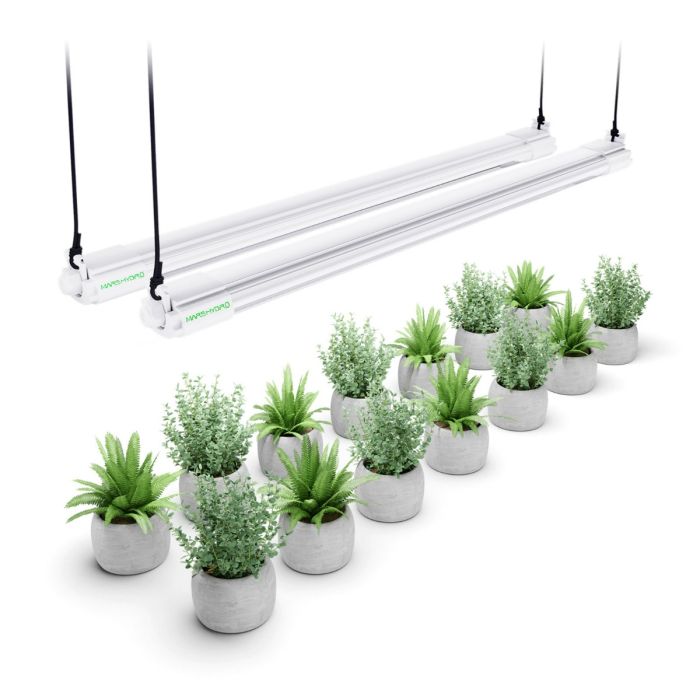
1. Setting Up: Place the LED lights approximately 4-6 inches above the Ivy Geraniums to ensure they receive adequate light without getting overheated.
2. Duration of Exposure: Expose the plants to LED lighting for about 8-12 hours a day. This duration replicates the natural daylight cycle, promoting healthy growth.
3. Regular Rotation: To ensure even growth and prevent legginess, rotate your Ivy Geraniums regularly under the LED lights. This helps all parts of the plant to receive equal light exposure.
4. Monitoring and Adjusting: Keep an eye on your plants' response to the LED lights. Adjust the distance and duration of exposure if necessary, based on the plant's growth and flowering response.
Summary
From understanding the allure of Ivy Geraniums to learning how to cultivate them, we’ve covered a lot of ground. We’ve delved into the essentials of lighting, soil and drainage, watering, and fertilizing. We’ve also explored the different varieties, pruning practices, and propagation methods. We’ve even discussed how to care for your Ivy Geraniums during winter and how to combat common pests and diseases. And let’s not forget about encouraging these plants to bloom with LED lights.
It’s clear that growing Ivy Geraniums involves more than just planting and watering. It’s a labor of love that requires knowledge, patience, and a keen eye for detail. But as any Ivy Geranium enthusiast would tell you, the reward - a cascade of vibrant, show-stopping blooms - is well worth the effort. So, whether you’re already an Ivy Geranium lover or just starting your journey, I hope this guide has been helpful. May your Ivy Geraniums always bloom as beautifully as the ones in my grandmother’s garden.
Frequently Asked Questions
- Do ivy geraniums need sun or shade?
Ivy geraniums grow best in light shade, so it's recommended to place them in a spot where they'll receive full sun most of the day, but in hotter climates, some protection from strong afternoon sun may be necessary. They are also adaptable to container planting with soil-less mix or planting beds with added organic matter.
- Does ivy geranium climb?
Ivy geraniums do not climb; instead, they are ideal for hanging baskets or as a colorful ground cover in the garden.
- Do red geraniums like sun or shade?
Red geraniums prefer full sun, but they can tolerate partial shade. It's best to remove old flowers to promote new growth, and to ensure the soil is well-drained.
- What makes Ivy Geraniums unique?
Ivy Geraniums are unique for their cascading blooms, vibrant colors, and suitability for hanging baskets and window boxes. They can thrive both indoors and outdoors.
- Can I propagate Ivy Geraniums?
Yes, you can propagate Ivy Geraniums through stem cuttings in the fall and then overwinter the new plants indoors for best results.


